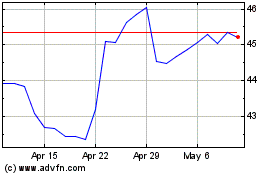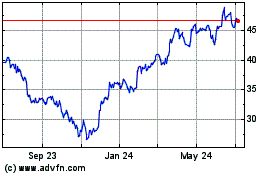GM's Chevrolet Volt Electric Car Will Be Sold in China as a Buick
April 18 2017 - 3:34PM
Dow Jones News
By Mike Colias
SHANGHAI -- General Motors Co.'s Chevrolet Volt electric car is
finally headed to China, but it won't be wearing the iconic bow tie
badge that identifies Chevy products. It will instead be sold as a
Buick.
The Detroit auto giant, already a major player in China's
traditional vehicle market, is planning a major push into an
emerging electric-vehicle segment.
The world's biggest automotive market, China has spurred demand
for battery-powered cars through a variety of government incentives
given to local auto makers. Now it is pressing foreign companies to
invest too, despite the industry's concerns about market demand and
intellectual-property protections.
GM on Tuesday unveiled the Buick Velite 5 during a party staged
on the eve of the Shanghai auto show. Based on the Volt, which was
seen as a breakthrough in the U.S. when it made its debut in 2010,
the new Buick travels about 70 miles on an electric charge before a
small gas engine takes over to extend the range by several hundred
miles, the auto maker said.
Fully-electric vehicles, such as the more capable Chevrolet Bolt
sold in the U.S., appear to be in the pipeline for introduction in
coming years.
A niche brand in the U.S., Buick is a big seller in China. It
sold more than 1 million vehicles in China last year, No. 2 in the
market behind Volkswagen's namesake brand.
The move is the start of heavier investment into China's EV
market by GM and other foreign auto makers, in part to meet
stringent regulations being proposed by the Chinese government.
Beijing last year outlined a plan to require an escalating
percentage of foreign auto makers' sales to be electrified cars in
coming years or they risk having their broader sales in China
curtailed.
"There's no question the government is steering some of these
decisions, " said Michael Dunne, founder of Dunne Automotive Ltd
and an industry consultant who spent years in China.
Until now, China's fast-growing EV market has been dominated by
cheap cars from Chinese brands -- spurred by ample government
incentives -- while foreign auto makers have mostly taken a
wait-and-see approach. Some have privately expressed wariness about
sharing their intellectual property on electrification with their
Chinese joint-venture partners.
Prodded by the prospect of government mandates, a number of
large auto makers recently have announced plans to push further
into China's EV market, including Ford Motor Co. and Volkswagen AG.
GM has said it would introduce at least 10 EVs and hybrids in China
by 2020.
Some large foreign auto makers have dabbled in EV sales in China
by shipping them from the U.S. or other countries. But those cars
are hit with a 25% tariff, making them uncompetitive against
cheaper Chinese entries.
GM and joint-venture partner SAIC Motor confirmed the Velite 5
will be built in China, allowing it to avoid the tariff and qualify
for government incentives. For example, EVs are exempt from license
plate fees in China that can run higher than $10,000 depending on
the city. GM said the car will be priced starting around $40,000
and qualify for a $5,400 subsidy from the manufacturer.
When the Volt made its debut in 2010 in the U.S., it was lauded
as a technological marvel, but sales have proved modest.
Repurposing it for Buick's China lineup could help justify battery
investments.
Write to Mike Colias at Mike.Colias@wsj.com
(END) Dow Jones Newswires
April 18, 2017 15:19 ET (19:19 GMT)
Copyright (c) 2017 Dow Jones & Company, Inc.
General Motors (NYSE:GM)
Historical Stock Chart
From Mar 2024 to Apr 2024

General Motors (NYSE:GM)
Historical Stock Chart
From Apr 2023 to Apr 2024
